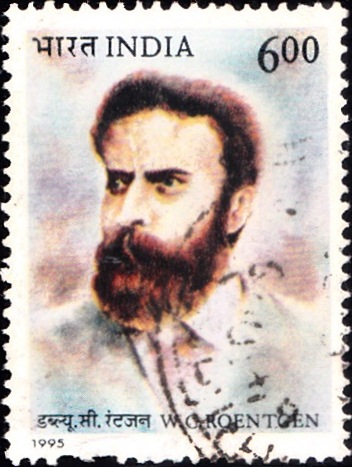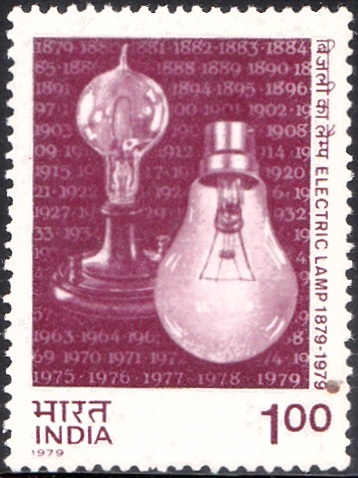
India on W.C. Roentgen
A commemorative postage stamp on the Centenary of the Discovery of X–rays / Röntgen rays by Wilhelm Röntgen, a German mechanical engineer and physicist :

 Issued by India
Issued by India
Issued on Nov 8, 1995
Issued for : The Department of Post today issues a stamp in honour of Roentgen to commemorate the 100th years of his discovery. The FDC shows the world’s first – “official” X-Ray taken by Roentgen.
Courtesy : V.C. Nadkarni‘s report on the Indian Radiological & Imaging Association‘s Annual Congress at Bombay, published in the Sunday Review 29.1.95; Bhabha Atomic Research Centre, Bombay.
Stamp Design : Suresh Kumar
Cancellation : Alka Sharma
Type : Stamp, Postal Used
Colour : Multi Colour
Denomination : 600 Paise
Overall size : 3.91 x 2.90 cms.
Printing size : 3.55 x 2.54 cms.
Perforation : 13 x 13
Paper : Imported un w/m Adhesive Gravure Coated Stamp Paper in sheets of size 53.5 x 50.8 cms.
Number of stamps Printed : 0.6 Million
Number per issue sheet : 35
Printing Process : Photogravure
Printer : India Security Press, Nasik
Name : Wilhelm Conrad Röntgen
Born on Mar 27, 1845 at Lennep, Rhine Province, German Confederation
Died on Feb 10, 1923 at Munich, Bavaria, Germany
About :
- Wilhelm Conrad Von Roentgen was born on March 27, 1845, at Lennep, a village in Rhine district in Germany. The story of his life is an interesting study. A man who became a celebrity as a physicist, a prolific mathematics research scholar and a teacher of eminence was dismissed from the High School for a foolish prank and was refused permission to the University of Utrecht. He had to migrate to Switzerland for completing his university studies from Swiss Federal Polytechnic School in Zurich.
- He made the momentous discovery of “X-rays“ of Roentgen rays in November 1895, publishing his observations in an obscure local journal of Warzburg in January 1896. Thomas Alva Edison confirmed his findings shortly after the announcement adding prophetically :“Professor Roentgen probably does not draw one dollar profit from his discovery. He belongs to those pure scientists who study for pleasure and love to delve into the secrets of nature. After they have discovered something wonderful, someone else must come to look at it from the commercial point of view. This will also be the case with Roentgen’s discovery.“
- Radiology began with the static radiograph or X-ray discovered by Roentgen. It went on to derive knowledge from space exploration and war defence technology. It moved from vacuum tubes to transistors, printed circuits on silicon chips. Miniaturisation, telecommunication & fine detail television screens assisted its development.
- Today the field has opened up remarkably. Computerised tomography or CT-Scans have been developed independently by Nobel prize winning South African physicist Allan M. Cormack and British engineer, Sir George Hounsfield. Positron Emission Tomography (PET), Ultrasound and magnetic resonance imagery (MRI) have added startling facets to radiology.
- What Roentgen discovered a hundred years ago has gone from strength to strength. Following the first paper “On a new kind of Rays (Preliminary Communication)“, he published two more papers on the subject. In April 1900 Roentgen was appointed Professor of Physics and Director of the Physical Institute at the Ludwigo Maximilians University in Munich. In 1901 he received the first Nobel prize in Physics. He retired in 1920, and soon thereafter he breathed his last on February 10, 1921.







